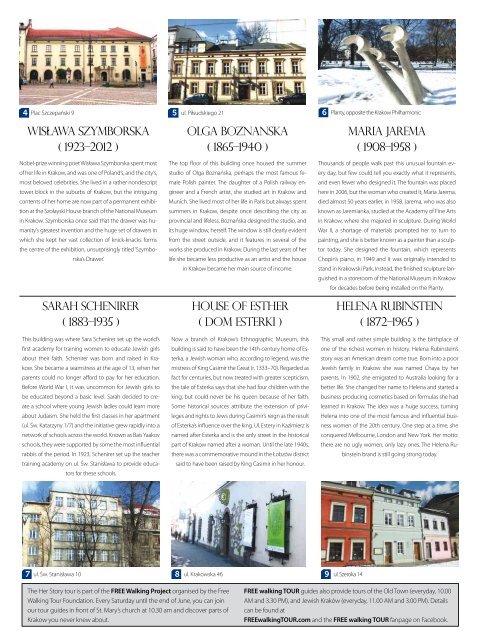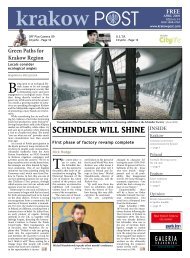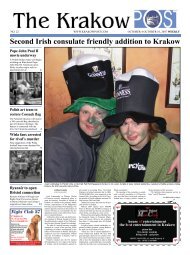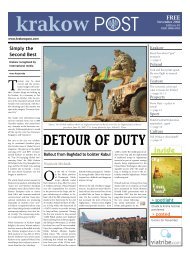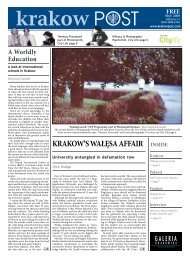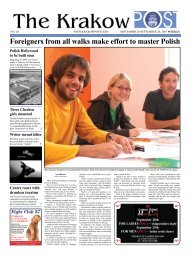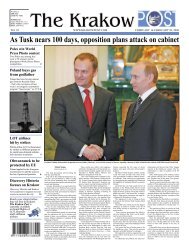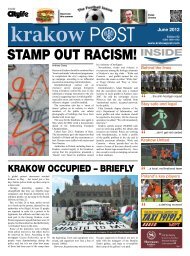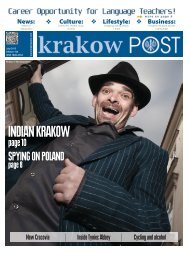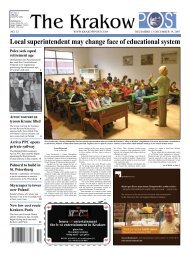News: Culture: Lifestyle: Business: Krakow ... - Krakow Post
News: Culture: Lifestyle: Business: Krakow ... - Krakow Post
News: Culture: Lifestyle: Business: Krakow ... - Krakow Post
You also want an ePaper? Increase the reach of your titles
YUMPU automatically turns print PDFs into web optimized ePapers that Google loves.
4 Plac Szczepański 9 5 ul. Piłsudskiego 21 6 Planty, opposite the <strong>Krakow</strong> Philharmonic<br />
Wislawa Szymborska<br />
( 1923–2012 )<br />
Nobel-prize winning poet Wisława Szymborska spent most<br />
of her life in <strong>Krakow</strong>, and was one of Poland’s, and the city’s,<br />
most beloved celebrities. She lived in a rather nondescript<br />
tower block in the suburbs of <strong>Krakow</strong>, but the intriguing<br />
contents of her home are now part of a permanent exhibition<br />
at the Szołayski House branch of the National Museum<br />
in <strong>Krakow</strong>. Szymborska once said that the drawer was humanity’s<br />
greatest invention and the huge set of drawers in<br />
which she kept her vast collection of knick-knacks forms<br />
the centre of the exhibition, unsurprisingly titled ‘Szymborska’s<br />
Drawer.’<br />
Sarah Schenirer<br />
( 1883–1935 )<br />
This building was where Sara Schenirer set up the world’s<br />
first academy for training women to educate Jewish girls<br />
about their faith. Schenirer was born and raised in <strong>Krakow</strong>.<br />
She became a seamstress at the age of 13, when her<br />
parents could no longer afford to pay for her education.<br />
Before World War I, it was uncommon for Jewish girls to<br />
be educated beyond a basic level. Sarah decided to create<br />
a school where young Jewish ladies could learn more<br />
about Judaism. She held the first classes in her apartment<br />
(ul. Św. Katarzyny 1/7) and the initiative grew rapidly into a<br />
network of schools across the world. Known as Bais Yaakov<br />
schools, they were supported by some the most influential<br />
rabbis of the period. In 1923, Schenirer set up the teacher<br />
training academy on ul. Św. Stanisława to provide educators<br />
for these schools.<br />
Olga Boznanska<br />
( 1865–1940 )<br />
The top floor of this building once housed the summer<br />
studio of Olga Boznańska, perhaps the most famous female<br />
Polish painter. The daughter of a Polish railway engineer<br />
and a French artist, she studied art in <strong>Krakow</strong> and<br />
Munich. She lived most of her life in Paris but always spent<br />
summers in <strong>Krakow</strong>, despite once describing the city as<br />
provincial and lifeless. Boznańska designed the studio, and<br />
its huge window, herself. The window is still clearly evident<br />
from the street outside, and it features in several of the<br />
works she produced in <strong>Krakow</strong>. During the last years of her<br />
life she became less productive as an artist and the house<br />
in <strong>Krakow</strong> became her main source of income.<br />
House of Esther<br />
( Dom Esterki )<br />
Now a branch of <strong>Krakow</strong>’s Ethnographic Museum, this<br />
building is said to have been the 14th-century home of Esterka,<br />
a Jewish woman who, according to legend, was the<br />
mistress of King Casimir the Great (r. 1333–70). Regarded as<br />
fact for centuries, but now treated with greater scepticism,<br />
the tale of Esterka says that she had four children with the<br />
king, but could never be his queen because of her faith.<br />
Some historical sources attribute the extension of privileges<br />
and rights to Jews during Casimir’s reign as the result<br />
of Esterka’s influence over the king. Ul. Estery in Kazimierz is<br />
named after Esterka and is the only street in the historical<br />
part of <strong>Krakow</strong> named after a woman. Until the late 1940s,<br />
there was a commemorative mound in the Łobzów district<br />
said to have been raised by King Casimir in her honour.<br />
Maria Jarema<br />
( 1908–1958 )<br />
Thousands of people walk past this unusual fountain every<br />
day, but few could tell you exactly what it represents,<br />
and even fewer who designed it. The fountain was placed<br />
here in 2006, but the woman who created it, Maria Jarema,<br />
died almost 50 years earlier, in 1958. Jarema, who was also<br />
known as Jaremianka, studied at the Academy of Fine Arts<br />
in <strong>Krakow</strong>, where she majored in sculpture. During World<br />
War II, a shortage of materials prompted her to turn to<br />
painting, and she is better known as a painter than a sculptor<br />
today. She designed the fountain, which represents<br />
Chopin’s piano, in 1949 and it was originally intended to<br />
stand in <strong>Krakow</strong>ski Park. Instead, the finished sculpture languished<br />
in a storeroom of the National Museum in <strong>Krakow</strong><br />
for decades before being installed on the Planty.<br />
Helena Rubinstein<br />
( 1872–1965 )<br />
This small and rather simple building is the birthplace of<br />
one of the richest women in history. Helena Rubinstein’s<br />
story was an American dream come true. Born into a poor<br />
Jewish family in <strong>Krakow</strong> she was named Chaya by her<br />
parents. In 1902, she emigrated to Australia looking for a<br />
better life. She changed her name to Helena and started a<br />
business producing cosmetics based on formulas she had<br />
learned in <strong>Krakow</strong>. The idea was a huge success, turning<br />
Helena into one of the most famous and influential business<br />
women of the 20th century. One step at a time, she<br />
conquered Melbourne, London and New York. Her motto:<br />
there are no ugly women, only lazy ones. The Helena Rubinstein<br />
brand is still going strong today.<br />
7 ul. Św. Stanisława 10 8 ul. <strong>Krakow</strong>ska 46 9 ul. Szeroka 14<br />
The Her Story tour is part of the FREE Walking Project organised by the Free<br />
Walking Tour Foundation. Every Saturday until the end of June, you can join<br />
our tour guides in front of St. Mary’s church at 10.30 am and discover parts of<br />
<strong>Krakow</strong> you never knew about.<br />
FREE walking TOUR guides also provide tours of the Old Town (everyday, 10.00<br />
AM and 3.30 PM), and Jewish Kraków (everyday, 11.00 AM and 3.00 PM). Details<br />
can be found at<br />
FREEwalkingTOUR.com and the FREE walking TOUR fanpage on Facebook.


